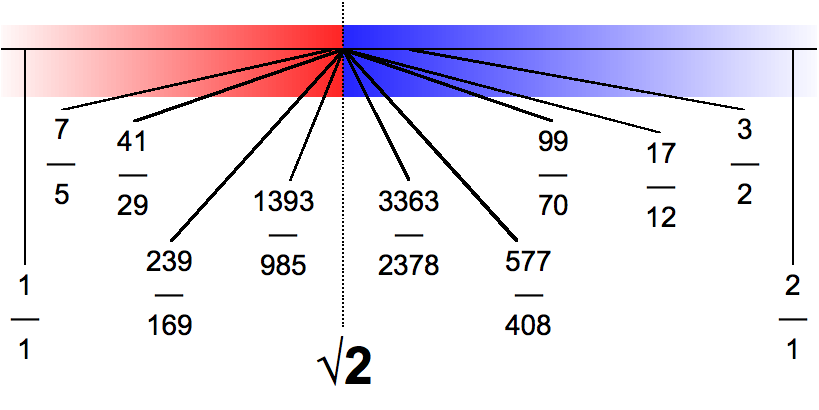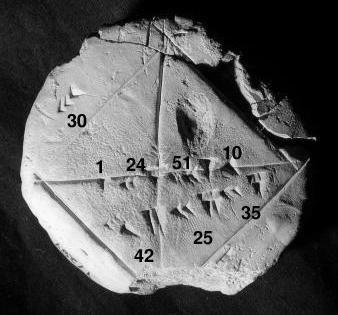|
Supremum
In mathematics, the infimum (abbreviated inf; : infima) of a subset S of a partially ordered set P is the greatest element in P that is less than or equal to each element of S, if such an element exists. If the infimum of S exists, it is unique, and if ''b'' is a lower bound of S, then ''b'' is less than or equal to the infimum of S. Consequently, the term ''greatest lower bound'' (abbreviated as ) is also commonly used. The supremum (abbreviated sup; : suprema) of a subset S of a partially ordered set P is the least element in P that is greater than or equal to each element of S, if such an element exists. If the supremum of S exists, it is unique, and if ''b'' is an upper bound of S, then the supremum of S is less than or equal to ''b''. Consequently, the supremum is also referred to as the ''least upper bound'' (or ). The infimum is, in a precise sense, dual to the concept of a supremum. Infima and suprema of real numbers are common special cases that are important in analy ... [...More Info...] [...Related Items...] OR: [Wikipedia] [Google] [Baidu] |
Totally Ordered Set
In mathematics, a total order or linear order is a partial order in which any two elements are comparable. That is, a total order is a binary relation \leq on some set X, which satisfies the following for all a, b and c in X: # a \leq a ( reflexive). # If a \leq b and b \leq c then a \leq c ( transitive). # If a \leq b and b \leq a then a = b ( antisymmetric). # a \leq b or b \leq a ( strongly connected, formerly called totality). Requirements 1. to 3. just make up the definition of a partial order. Reflexivity (1.) already follows from strong connectedness (4.), but is required explicitly by many authors nevertheless, to indicate the kinship to partial orders. Total orders are sometimes also called simple, connex, or full orders. A set equipped with a total order is a totally ordered set; the terms simply ordered set, linearly ordered set, toset and loset are also used. The term ''chain'' is sometimes defined as a synonym of ''totally ordered set'', but generally refers to a ... [...More Info...] [...Related Items...] OR: [Wikipedia] [Google] [Baidu] |
Empty Set
In mathematics, the empty set or void set is the unique Set (mathematics), set having no Element (mathematics), elements; its size or cardinality (count of elements in a set) is 0, zero. Some axiomatic set theories ensure that the empty set exists by including an axiom of empty set, while in other theories, its existence can be deduced. Many possible properties of sets are vacuously true for the empty set. Any set other than the empty set is called ''non-empty''. In some textbooks and popularizations, the empty set is referred to as the "null set". However, null set is a distinct notion within the context of measure theory, in which it describes a set of measure zero (which is not necessarily empty). Notation Common notations for the empty set include "", "\emptyset", and "∅". The latter two symbols were introduced by the Bourbaki group (specifically André Weil) in 1939, inspired by the letter Ø () in the Danish orthography, Danish and Norwegian orthography, Norwegian a ... [...More Info...] [...Related Items...] OR: [Wikipedia] [Google] [Baidu] |
Completeness Of The Real Numbers
Completeness is a property of the real numbers that, intuitively, implies that there are no "gaps" (in Dedekind's terminology) or "missing points" in the real number line. This contrasts with the rational numbers, whose corresponding number line has a "gap" at each irrational value. In the decimal number system, completeness is equivalent to the statement that any infinite string of decimal digits is actually a decimal representation for some real number. Depending on the construction of the real numbers used, completeness may take the form of an axiom (the completeness axiom), or may be a theorem proven from the construction. There are many equivalent forms of completeness, the most prominent being Dedekind completeness and Cauchy completeness ( completeness as a metric space). Forms of completeness The real numbers can be defined synthetically as an ordered field satisfying some version of the ''completeness axiom''. Different versions of this axiom are all equivalent ... [...More Info...] [...Related Items...] OR: [Wikipedia] [Google] [Baidu] |
Real Numbers
In mathematics, a real number is a number that can be used to measurement, measure a continuous variable, continuous one-dimensional quantity such as a time, duration or temperature. Here, ''continuous'' means that pairs of values can have arbitrarily small differences. Every real number can be almost uniquely represented by an infinite decimal expansion. The real numbers are fundamental in calculus (and in many other branches of mathematics), in particular by their role in the classical definitions of limit (mathematics), limits, continuous function, continuity and derivatives. The set of real numbers, sometimes called "the reals", is traditionally mathematical notation, denoted by a bold , often using blackboard bold, . The adjective ''real'', used in the 17th century by René Descartes, distinguishes real numbers from imaginary numbers such as the square roots of . The real numbers include the rational numbers, such as the integer and the fraction (mathematics), fraction . ... [...More Info...] [...Related Items...] OR: [Wikipedia] [Google] [Baidu] |
Least-upper-bound Property
In mathematics, the least-upper-bound property (sometimes called completeness, supremum property or l.u.b. property) is a fundamental property of the real numbers. More generally, a partially ordered set has the least-upper-bound property if every non-empty subset of with an upper bound has a ''least'' upper bound (supremum) in . Not every (partially) ordered set has the least upper bound property. For example, the set \mathbb of all rational numbers with its natural order does ''not'' have the least upper bound property. The least-upper-bound property is one form of the completeness axiom for the real numbers, and is sometimes referred to as Dedekind completeness.Willard says that an ordered space "X is Dedekind complete if every subset of X having an upper bound has a least upper bound." (pp. 124-5, Problem 17E.) It can be used to prove many of the fundamental results of real analysis, such as the intermediate value theorem, the Bolzano–Weierstrass theorem, the extreme valu ... [...More Info...] [...Related Items...] OR: [Wikipedia] [Google] [Baidu] |
Hyperreals
In mathematics, hyperreal numbers are an extension of the real numbers to include certain classes of infinite and infinitesimal numbers. A hyperreal number x is said to be finite if, and only if, , x, [...More Info...] [...Related Items...] OR: [Wikipedia] [Google] [Baidu] |
Square Root Of 2
The square root of 2 (approximately 1.4142) is the positive real number that, when multiplied by itself or squared, equals the number 2. It may be written as \sqrt or 2^. It is an algebraic number, and therefore not a transcendental number. Technically, it should be called the ''principal'' square root of 2, to distinguish it from the negative number with the same property. Geometrically, the square root of 2 is the length of a diagonal across a Unit square, square with sides of one unit of length; this follows from the Pythagorean theorem. It was probably the first number known to be irrational number, irrational. The fraction (≈ 1.4142857) is sometimes used as a good Diophantine approximation, rational approximation with a reasonably small denominator. Sequence in the On-Line Encyclopedia of Integer Sequences consists of the digits in the decimal expansion of the square root of 2, here truncated to 60 decimal places: : History The Babylonian clay tablet YBC 7289 (–1 ... [...More Info...] [...Related Items...] OR: [Wikipedia] [Google] [Baidu] |
Well-order
In mathematics, a well-order (or well-ordering or well-order relation) on a set is a total ordering on with the property that every non-empty subset of has a least element in this ordering. The set together with the ordering is then called a well-ordered set (or woset). In some academic articles and textbooks these terms are instead written as wellorder, wellordered, and wellordering or well order, well ordered, and well ordering. Every non-empty well-ordered set has a least element. Every element of a well-ordered set, except a possible greatest element, has a unique successor (next element), namely the least element of the subset of all elements greater than . There may be elements, besides the least element, that have no predecessor (see below for an example). A well-ordered set contains for every subset with an upper bound a least upper bound, namely the least element of the subset of all upper bounds of in . If ≤ is a non-strict well ordering, then < is a st ... [...More Info...] [...Related Items...] OR: [Wikipedia] [Google] [Baidu] |
Integer
An integer is the number zero (0), a positive natural number (1, 2, 3, ...), or the negation of a positive natural number (−1, −2, −3, ...). The negations or additive inverses of the positive natural numbers are referred to as negative integers. The set (mathematics), set of all integers is often denoted by the boldface or blackboard bold The set of natural numbers \mathbb is a subset of \mathbb, which in turn is a subset of the set of all rational numbers \mathbb, itself a subset of the real numbers \mathbb. Like the set of natural numbers, the set of integers \mathbb is Countable set, countably infinite. An integer may be regarded as a real number that can be written without a fraction, fractional component. For example, 21, 4, 0, and −2048 are integers, while 9.75, , 5/4, and Square root of 2, are not. The integers form the smallest Group (mathematics), group and the smallest ring (mathematics), ring containing the natural numbers. In algebraic number theory, the ... [...More Info...] [...Related Items...] OR: [Wikipedia] [Google] [Baidu] |
Maximal Element
In mathematics, especially in order theory, a maximal element of a subset S of some preordered set is an element of S that is not smaller than any other element in S. A minimal element of a subset S of some preordered set is defined dually as an element of S that is not greater than any other element in S. The notions of maximal and minimal elements are weaker than those of greatest element and least element which are also known, respectively, as maximum and minimum. The maximum of a subset S of a preordered set is an element of S which is greater than or equal to any other element of S, and the minimum of S is again defined dually. In the particular case of a partially ordered set, while there can be at most one maximum and at most one minimum there may be multiple maximal or minimal elements. Specializing further to totally ordered sets, the notions of maximal element and maximum coincide, and the notions of minimal element and minimum coincide. As an example, in the collecti ... [...More Info...] [...Related Items...] OR: [Wikipedia] [Google] [Baidu] |

